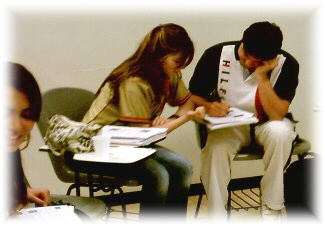Leveraging Young Learners’ Use of Technology
Young learners born between Generation Y and Z have grown up with technology that helps them engage with a constant flow of information and data. Yet the constant question from early 21st century teachers is, ‘How can we adopt technology in our classes in a meaningful way that facilitates learning?’ This is a good question we should ask whenever we use tech in our teaching, but it’s easily answered if we leverage the ways our learners are already interacting daily with technology. Here are five ideas that might help.
Don’t be afraid of technology
Although YLs are most commonly described as tech savvy, I have trouble with this term as I feel it poorly depicts their true interactions with technology. What I have come to understand is that our young learners are actually tech comfy, rather than tech savvy. Realizing this,we can overcome our own fears of technology and adopt the tools they already use to facilitate learning.
Teach proper search skills
By 2006 about 90% of young Westerners used Internet search engines. It’s now virtually 100% with an ease-of-use mentality at the heart of this phenomenon. While Gen Y-ers still recognize the value of physical libraries, such facilities fail to live up to their expectations of speed and convenience. This high comfort level, however, fosters a false sense of ability: young learners often overestimate their skills in finding and – especially – in evaluating online information. So, one of the first things we must do as teachers is offer guidance in how to use search engines effectively. Fortunately, there are resources such as this infographic to help us achieve this.
Use visuals more effectively
In many cases, technology is enabling us to meet teaching aims in ways we could only imagine in the past. Whereas we used to search through our possessions for meaningful realia to elicit language in class, we can now use online visuals. Infographics like Nik Peachey’s Infographic Tools (a great starting point) and YouTube video clips shouldn’t be considered as the new alternative to reading, though, as they are not an adequate replacement for the development of reading skills. However, they are a great way of stimulating interest and activating schemata.
Leverage technology to give feedback
Those few lines of red scribbled notes on a learner’s writing homework have never been adequate feedback; this is one aspect of teaching that has been greatly enhanced with tech tools. Gen Y-ers have grown up receiving instant feedback on their performance, so they can feel let down if we don’t give them the same level of response to their learning. Using audio recording tool Audacity or something like Class Dojo allows us to record thousands of words of feedback in the time it used to take to write two or three sentences.
Handle multitasking with care
Recent research suggests that teenagers currently spend more than three hours a day connected to at least two tech gadgets — from a total of more than ten hours spent plugged into at least one. I’ve heard such statistics used to justify classroom multitasking, but I’m not convinced it’s a great thing to encourage. The problem is — and Carnegie Mellon University research backs this up — that a young brain working on two tasks has much less overall brain activity than if they were focused on one task. It’s doing less trying to do more. I’d suggest exercising great care dealing with multitasking in class, especially when doing something creative – which it’s believed suffers the most from multitasking. If learners are looking up words in an online dictionary while doing another task, it’s probably Ok. However, if creativity is your aim, keep multitasking to a minimum.
I hope you now feel it’s a good thing to be using technology in class and that you don’t have to go over the top. Indeed, you can be successful simply exploiting the ways learners already use technology on a day-to-day basis in their lives.




It is true that the Yand Z generation is the tech one. Never knew about the tools ‘audacity and class dojo’. Sure will give it a try. I use a lot the whatsapp on phones to comunicate to students and their parents as it allows a 1 minute instant voice message. I use technology in almost all my class as I am presently work mainly with digital materials and internet connections so it is second nature to me. Of course as you say, we have to handle it with care in and out of class. It is here to stay as it is already part of our lives.
I agree with your idea that the young learners are tech comfy more than savvy…they don’t actually know how to use this tech responsibly. My students are kind of glued to their gadgets, and it takes time to make them understand WHEN it is ok to use them , and when and why not. That’s why I found this infographic interesting http://cdn-media-2.lifehack.org/wp-content/files/2013/10/Google-like-a-boss.png ( the link in your post doesn’t show the pic, so I googled…I don’t know if it is the same), but made me aware of somethings I did not usually pay attention to.
And about multitasking, it is rare that I use it or allow it in class, despite my students complaints. I want them to focus on ONE thing at a time, so I can be sure
that they complete the task, or that they don’t miss any steps… they do chat a lot while working, so for me, that is as much “multitasking” I’d allow.
I totally agree with you, Adam. My pre-teens and teens always use their gadgets. They love using them. For sure, my students and I are from different generations, and sometimes I don’t understand how it can be possible to spend all summer vacations playing “DOTA2” without even hanging out with their friends.
They’re multitasking. It’s not only interesting for them to do one thing, but also not exciting either.
I like using interesting videos from Youtube, or apps to encourage my students, and draw their attention. They love it, and they memorize new vocabulary better, and after that they use it in their free speech tasks more.
On the other hand, I’m not for using new technologies every lesson a lot. It can probably be compared to eating candies. If you eat them too much, you don’t feel the taste of them, they become like a routine for you. They same happens when we use too much of new technologies in the classroom. To my mind, it’s better use it but “in portions”, so that students aren’t tired or got used to it a lot.
Thank you so much for sharing these two tools with us. I’ve just tried Class Dojo and realized what a great example of using technology to have students’ feedback it is. I can hardly wait to start a new scool year! I apsolutely agree with you that it’s a good way to exploit technology at least the way students do it and then learn every day something new and implement it into our teaching.
In September 2012 I started a new project which emerged from the needs of the new generation. The idea of creating a teaching blog as educational media in teaching English as a second language was the solution of the question as the form is very popular among young people. The aim of the project was to improve language skills in real situations and contribute to the development of creativity and critical thinking . The objectives predetermined the selection of Internet applications : Class Tools, Voki, Polldaddy, Google Drive, Glogster, Edmodo and YouTube. I created interactive exercises , games, activities for listening and reading comprehension , tests and virtual classroom . The tools provided daily practice for my students to do at home in order to reinforce the taken material, improve knowledge and skills , develop critical thinking and creativity, students became active participants who took responsibility for their education into their own hands . http://kolarska.com/ . One of my favorite tools is Glogster . We were studying about heroes and leaders so I decided to create a Glog Story about my heroes and uploaded video material on it. http://charlotte65.edu.glogster.com/national-heroes-and-leaders/ I challenged my students to create engaging Glog stories about their heroes. I gave them the design brief and suggested they thought of their peers as the target audience. I used my Glog as a base for learning the vocabulary in a creative way and to develop students’ communication and media production skills. I asked them to dream up what their Glog stories could be about and share ideas with a partner with what I hoped to develop planning, collaborative and creativity skills. I asked students to find out information about their heroes, to think of and sort it out, to make a plan. In my classes students are divided into groups of four, so I asked them to work in collaboration and create mind maps of their findings, make plans and comment. When the task was completed, we discussed it, expressed opinion, evaluated the work and developed criteria for assessing the Glog stories. I also asked the students to consider what they could teach their partner using their Glog stories and pay attention to the criteria of assessment. The students designed their Glog stories at home and uploaded them on the Glogster platform, at school we concentrated on developing editing skills, expressing opinions and comments and assessment of the task.
I agree with Adam my learners are always glued to their phones, laptops, etc. One needs to use this same technology to stimulate their interest in the lesson. However, as Adam says, too much is not ideal either so they get bored if the YouTube clip or the PowerPoint is too long. They need to be presented with a balance of technology and non-technology. I also agree that they like quick feedback so I tried giving assignments on our Moodle platform which allows one to give feedback. This works for those that know how to access the platform. In South Africa, many university students have not previously had access to technology so find it hard.
I’m writing this post directly after having watched your recorded iTDi session; “10 Ways to Engage Generation Y with Technology”. This was a great session, and I had many “Ah, that explains it!” moments, thinking about my classes and the different ages of the students I teach here in Barcelona, Spain. Having only recently qualified as a teacher (last September), I have the “advantage” of being very open to using technology in my classes, despite being part of “Generation X”. Not to say that teachers who have been teaching for many years are at a disadvantage, far from it, but I haven’t had to “relearn” any teaching techniques.
I agree that Generation Y students are not always as “tech savvy” as one might think. They often know the fastest route to get the information they need, but, I feel, have perhaps missed out on the potential learning opportunities one might have on a longer journey. The demand is for information NOW and not information – HOW?
Whilst being up to date with modern technology is a must in this day and age, both for students and teachers, I have to admit I find it a little sad (perhaps sad is not exactly the right word, but it’s the closest I can find at the moment) to see an image of a whole class of Generation Y or Z learners all facing their laptops/tablets/devices and not talking to each other. But that’s just my personal opinion, and who am I to stand in the way of progress?
On a more positive note, the use of technology made available to us teachers at the moment is fantastic, and I’m hungry for more. Correction tools (e.g. http://www.LangCorr.com), tools for making videos, lesson plans incorporating videos, class polls, interactive grammar tools, etc., etc., all help to enrich the learning environment of the student and the teaching environment of the teacher, as long as they are used correctly. This can only be a positive thing for all concerned, right? Who knows where we will go from here – I, personally, can’t wait! It’s all so exciting!
I enjoyed the post. I am happy that I am not afraid of technology. I love it personally and in the classroom. Technology is a great tool but it is in no way the crux of teaching.
Thanks again:) Happy writing………………
Like all the people here who have commented on the post, I agree with your idea that the young learners are tech comfy more than tech savvy…and with Queralt saying ‘they don’t actually know how to use this tech responsibly. My students are kind of glued to their gadgets, and it takes time to make them understand WHEN it is ok to use them , and when and why not.’ – This is as if I was describing my students as well 🙂 (those 11 – 14 years old).
Unfortunatelly my shool lacks equipment so we can’t use technology in class (we only have a CD player) and I know how much we miss that.
Hi Adam,
It was just great as always. I share the same opinion with you on that using technology has its own guidelines and the first step to take benefits from it especially for teachers who know technology as an intruder in the classrooms is to learn how to use it. I think, teachers criticizing tech-based teaching/learning or using a tinge of technology in their teaching practices are all on the same boat of being technophobe and it is mainly because they still do not know how to use technological devices. First teachers should make friend with technology by learning to use it productively.
Using technology in the classroom creates excitement for students and facilates learning.
but young learners,as Adam said, are actually tech comfy, rather than tech savvy.In this way, we can adopt tools that make learning interactive. For axample ,using videos is a great way to engage students while teaching them valuable information.